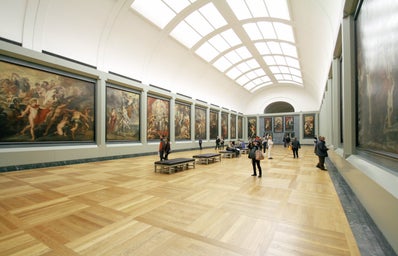The term “Karen” has circulated through popular culture and media since 2020, and so far, it does not show signs of slowing down. For those of you who are not yet familiar with the terminology, a “Karen” is traditionally a “middle-class white woman, who exhibits behaviours that stem from privilege.” But anyone can be a “Karen,” so long as you are pushy, whiny, and always making problems out of things that don’t remotely affect you.
This article could easily talk forever about the nature of “Karens,” but instead, I want to focus on my favorite “Karen.” The original “Karen.”
I was studying abroad in Italy during the summer of 2022. My cohort and I made the drive from Belmonte in Sabina, where we were staying, to the Vatican City. After covering my knees and shoulders, I stepped inside the Sistine Chapel for the first time. I still remember the grandeur, the ostentation, and the absolute beauty, as I scanned my eyes wildly throughout the room and saw nothing but frescoes. Of course, my eyes first rested on the ceiling frescoes: The Creation of Eve, The Delphic Sibyl, The Creation of Adam, The Fall and Expulsion from the Garden of Eden, and The Deluge to name a few. But once my neck started to strain from looking directly upwards for ten minutes, I moved my gaze down to The Last Judgment fresco behind the main altar.
There is, of course, much to notice about this fresco. It is one of Michelangelo’s most famous works, and even if you don’t recognize the name The Last Judgment, you have seen it somewhere. It is described as “one of the most terrifying visions of divine retribution ever painted.” An image of Christ takes the central focus, surrounded by what feels like hundreds of nude saints and sinners. He guides the former up to heaven and condemns the latter down to hell. As my eyes glazed over in awe, I moved closer until I was standing with the rest of my group. It was pretty quiet in the chapel, and I remember one of the program coordinators leaned over and said the words that changed my life as an art historian forever: “You’ve heard of Il Braghettone, yes?” No, I had not.
Il Braghettone, or Daniele da Volterra, was a Mannerist Italian painter and sculptor. He was the incredible artist behind the Descent from the Cross (c. 1545), which is located at the Trinità dei Monti in Rome, and The Prophet Elias (c. 1550-1560), which is currently on display at the Uffizi Gallery in Florence. His work is the contemporary exemplum used by many Art History professors to define the era of Mannerism. He is famous for his winding, serpent-like forms and exaggerated darkness and shadow. But despite his impressive portfolio of emotionally moving and compositionally harmonious pieces, nothing could save him from his fatal flaw, which befell him on what I assume was one dark day in 1564.
I mentioned earlier that The Last Judgment was filled to the brim with nude figures, but what I have not yet mentioned is how the Catholic Church felt about this. Michelangelo reportedly claimed that the “perfection of the nude human form was both the highpoint of artistic creation and the purest expression of the divine in the world of men.” So it makes sense that his commission to paint the Sistine Chapel would include a plethora of his favored nude figures. However, when Pope Paul III and Biagio da Cesena came to view Michelangelo’s work in progress, they remarked that “the decorations were more fitting for a brothel than the pope’s private chapel.” Michelangelo obviously rejected these criticisms, and retaliated by adding more nude figures and even depicting his belittler, Biagio da Cesena, as Minos, a judge in the underworld with a snake biting down on his genitals. Unsurprisingly, Biagio advocated for the fresco to be covered up, but to no avail. The Last Judgment thus remained unchanged from its completion in 1541 until 1564.
This brings us back to the star of our story, Daniele da Volterra. For it was to Daniele da Volterra that Popes Paul IV and Pius IV turned to when they decided it was time to cover up Michelangelo’s hilarious and penis-shaped acts of retribution. The Catholic Church was in the process of dealing with the Protestant Reformation by launching their Counter-Reformation. They were cleaning up their public image, and I guess that in order to demand the improvement of public morality, they needed to remove the phallic imagery from the pope’s private chapel. Sort of like a practice what you preach approach. And so Daniele da Volterra carefully sheathed each and every exposed genital with various loincloths and coverings, an act that would forever reward him with the funniest nickname known to man: Il Braghettone, or, “the underpants-maker.”
There isn’t a great deal of information on the specifics of Daniele da Volterra’s life before or after his completion of this commission. Unfortunately, toxic media and gossip columns were perhaps not as developed in the 1500s as they are now. However, whatever his personal motivations or religious beliefs were, I think it is obvious that his willingness to involve himself in social censorship gives us the full right to give him the harsh name of Il Braghettone, and the even harsher name, “Karen.”
I do hesitate to place the full blame on him. After all, Biagio da Cesena was the most vocal advocate for covering up the immodesties in the fresco. If, for posterity, we want to knight him as the first “Karen,” there will be no complaints from me. But I hope that we can all agree that this is one of the funniest art controversies in history, and I hope you all love the story of Il Braghettone as much as I do.


